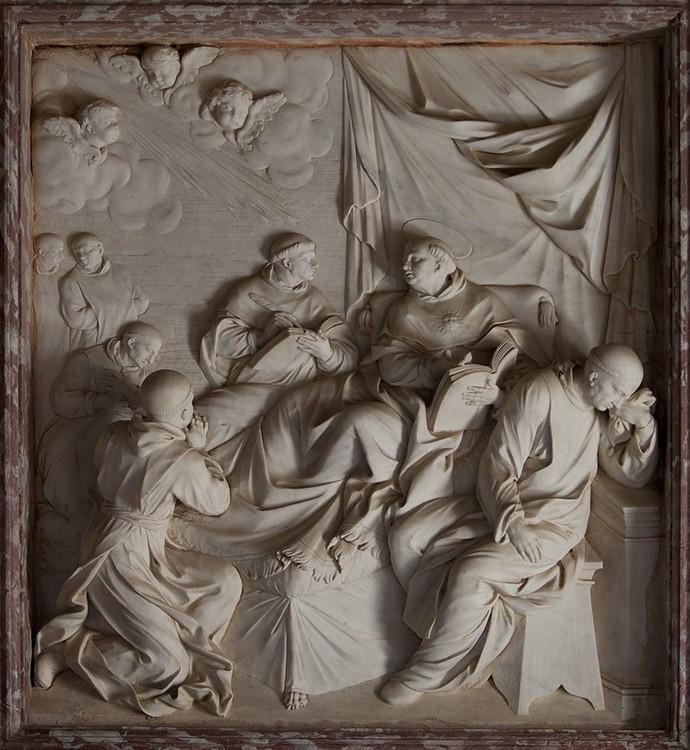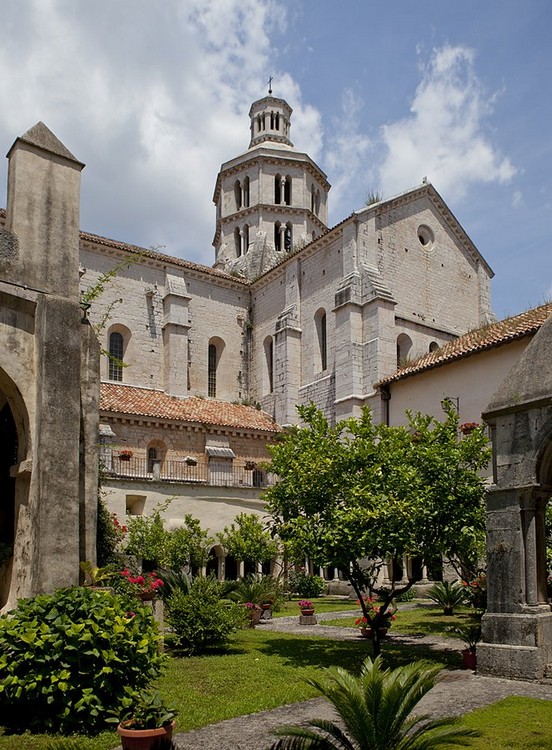
Today, January 28, is the Feast of Saint Thomas Aquinas. He is, of course, a great Doctor of the Church and perhaps her greatest theologian, certainly one her most influential thinkers. He is rightly commended for integrating natural reason (especially as exemplified in the thought of Aristotle) with the Christian faith, and so contemporary Catholics (and other Christians more generally) look to Saint Thomas as paradigmatically harmonizing science and religion. He was also a philosopher of noted ability and his insights into natural philosophy (physics), metaphysics, philosophy of religion, philosophy of mind, ethics and politics are still vigorously debated and defended even among secular academics. Not surprisingly, most of the attention paid to the Angelic Doctor focuses on the light he brings to the issues of our own day. However, the impact he had on his medieval contemporaries and their own rather intense interest in his person, perhaps more than in his writings, often gets neglected. This difference in focus is reflected in the two dates that have served as the day for celebrating his sainthood.
St. Thomas’s Feast Day on the general calendar for the Roman Church used to be the day of his death (or birth into eternal life), March 7, from the time of his canonization in 1323 until the reform of the liturgy in 1969 after the Second Vatican Council which restored a more penitential focus to the season of Lent by removing from it many saints’ day celebrations which had accumulated on the calendar over the centuries. Sometimes this shift in St. Thomas’s feast day is decried as another affront to tradition by Vatican II. What seems to often be overlooked, however, is that January 28 was an important commemoration of St. Thomas for the friars of his own Order of Preachers, the Dominicans, and it speaks to medieval preoccupations that differ markedly from our own modern concerns.

As is well known, on December 6, 1273, Saint Thomas had some sort of mystical experience while saying Mass in the Dominican convent of San Domenico Maggiore in Naples, after which he stopped writing his as yet unfinished magnum opus of the Summa Theologiae. Having only completed Quaestio 73-83 of the Tertia Pars on the Holy Eucharist, he was in the middle of his treatment on the Sacrament of Penance. Eventually, he confided to his secretary that he could write no more, since after what had been revealed to him, it seemed that what he had written was only so much straw.

Apparently, that very day, Saint Thomas was summoned to the Second Council of Lyon, where, as some authors have suggested, he would be made a cardinal of the Church, as indeed Saint Bonaventure, his Franciscan contemporary had been. Despite his mystical experience, friar Thomas dutifully set out for France and the church council. Yet fate, or Divine Providence, would intervene. (Queue ominous music.)

Photo credit: Lubos Rojka
Saint Thomas never made it far beyond Naples when he fell ill on the journey, possibly hitting his head on a low hanging branch. He was ultimately brought to the Cistercian Abbey of Fossanova where he lingered for some times, and requested that the Song of Songs from the Bible be read to him, or as is sometimes related, he began a commentary on this text. Nevertheless, he soon succumbed to his illness or injury and died on March 7, 1274. Thus, as is usually the case, this date was assigned as his Feast Day when he was canonized in 1323 by Pope John XXII.
After his death, however, the Cistercians recognizing St. Thomas’s evident sanctity and already well-established intellectual renown, eagerly held on to his mortal remains as relics for a pilgrimage destination. The monks thus refused the entreaties of the Dominican friars to have him buried among his brethren. Supposedly, the monks translated his remains a number of times within the monastery, and in the course of one such journey, it was discovered that St. Thomas’s body was incorrupt and exuded a sweet fragrance. It has been alleged, perhaps libelously, that so intent were the Cistercian on retaining possession of St. Thomas’s relics, that they boiled his previously incorrupt body down to its bones, and hid them in a niche in a wall. [NB: I haven’t seen this account documented anywhere, but it was told to me (perhaps unreliably) when I was a young and perhaps naïve Dominican friar.] As is indicated below, however, various parts or bones of the body formerly known as St. Thomas were distributed around Europe, so his body did not remain incorrupt and intact forever.
Eventually, in 1369, at the instruction of Pope Urban V, after many and repeated requests from the Dominican Order, St. Thomas’s remains were returned to his religious brethren. It was on this date, January 28, that the relics of his body completed their journey from Fossanova in Italy and were interred in the motherhouse of the Order, the Jacobin Convent in Toulouse. To commemorate that day, the Dominican Order celebrated another Feast Day for Saint Thomas. After the reform of the general Roman calendar and March 7 was given again to the penances of Lent, the Catholic Church made the day Saint Thomas’s relics were returned to his religious brothers his Feast Day for the universal Church to celebrate his life, teaching and preaching.

There, in Toulouse, his remains remained until the French Revolution in 1789 when they were transferred for safe keeping to the Basilica Church of Saint-Sernin, but they were returned again to the Dominican convent in 1974 for the 700th anniversary of his death. Thus, under an altar in the Dominican church, a reliquary was constructed to serve as the tomb of Saint Thomas. (For more details about circumstances of the translation of the remains of St. Thomas up to their transfer to the Basilica of Saint-Sernin, see this article from Brevarium S.O.P.)
Apparently, though, not all of Saint Thomas’s relics are kept in Toulouse. The thumb of Saint Thomas resides in the Dominican church of Sant’Eustorgio in Milan, while a bone from his left arm is in an arm-shaped reliquary in the church of San Domenico Maggiore in Naples where he lived and taught. His other arm was given to the Dominican convent of Saint James in Paris, but that convent was suppressed and destroyed after the French Revolution. (I have not read what happened to this relic.) His head also was given for a time to the cathedral of Priverno in Latium, Italy, but it seems also to have been reunited with much of the rest of his remains and returned to the care of the Dominicans in Toulouse. Certainly Thomas Aquinas is not the most post mortem widely travelled or widely distributed saint of the middle ages, but rather, his case seems oddly typical of medieval interest in relics. Indeed, Marika Räsänen has recently published a study of the journeys and vicissitudes of St. Thomas’s remains as emblematic of the importance relics had in the height of the medieval period: Thomas Aquinas’s Relics as Focus for Conflict and Cult in the Late Middle Ages: The Restless Corpse.
While such intense interest in the relics of Saint Thomas seems to us perhaps somewhat odd and even macabre, even to the point of missing the true significance of his life and work, Saint Thomas himself acknowledges that such devotion is right and fitting as it is an extension of the honor and veneration that ought to be given to the Body of Jesus Christ. It is indeed for the Angelic Doctor one of the furthest expressions of the Incarnation whereby lowly matter is exalted and made worthy of honor by being united with a very Person God as the saints were temples and instruments of God’s presence in this very material world.
Now it is manifest that we should show honor to the saints of God, as being members of Christ, the children and friends of God, and our intercessors. Wherefore in memory of them we ought to honor any relics of theirs in a fitting manner: principally their bodies, which were temples, and organs of the Holy Ghost dwelling and operating in them, and are destined to be likened to the body of Christ by the glory of the Resurrection. Hence God Himself fittingly honors such relics by working miracles at their presence.
Summa Theologiae, IIIa, q. 25, a. 6
It seems this recognition of the sacredness of the physical is yet another refutation of that heresy, Manicheanism, the bane of all Dominicans, which saw matter and the body as evil and from a source other than the God of Spirit. It is fitting that what remains of Saint Thomas’s own substantial matter, his earthly body, should be the object of intense Catholic interest, and so sought-after by the medievals who understood, perhaps better than us moderns, that all creation, even the dust and muck of earth, is created by God, and is sanctified through His use of it for His divine purposes. It is fitting, too, that the day that saw Thomas’s own body transferred to its final (?) resting place should be the day the universal Church honors the Universal Doctor dedicated, among other concerns, to refuting Manichean dualism, and championing Aristotelian hylomorphism.



Reblogged this on Nelson MCBS.
LikeLike